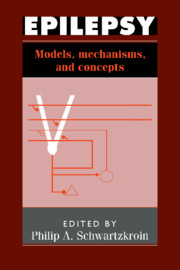Book contents
- Frontmatter
- Contents
- List of contributors
- General introduction
- Section 1 Chronic models in intact animals – concepts and questions
- Section 2 Features of the epileptogenic brain
- Section 3 ‘Normal’ brain mechanisms that support epileptiform activities
- Introduction
- 11 Brain slice models for the study of seizures and interictal spikes
- 12 Generation of epileptiform discharge by local circuits of neocortex
- 13 Study of GABAergic inhibition and GABAA receptors in experimental epilepsy
- 14 High potassium-induced synchronous bursts and electrographic seizures
- 15 Anti-epileptic effects of organic calcium channel blockers in animal experiments
- Recent advances
- Index
12 - Generation of epileptiform discharge by local circuits of neocortex
from Section 3 - ‘Normal’ brain mechanisms that support epileptiform activities
Published online by Cambridge University Press: 03 May 2010
- Frontmatter
- Contents
- List of contributors
- General introduction
- Section 1 Chronic models in intact animals – concepts and questions
- Section 2 Features of the epileptogenic brain
- Section 3 ‘Normal’ brain mechanisms that support epileptiform activities
- Introduction
- 11 Brain slice models for the study of seizures and interictal spikes
- 12 Generation of epileptiform discharge by local circuits of neocortex
- 13 Study of GABAergic inhibition and GABAA receptors in experimental epilepsy
- 14 High potassium-induced synchronous bursts and electrographic seizures
- 15 Anti-epileptic effects of organic calcium channel blockers in animal experiments
- Recent advances
- Index
Summary
Introduction
So many books have been written on epilepsy that it may seem rash to add another …
(Jackson, 1874)1
The neuronal essence of seizures is exceptionally synchronous activity. Cortical neurons performing normal tasks tend to fire with relatively low synchrony (Abeles, 1982), but during a seizure the activity of affected neurons is abruptly usurped. The kernel of this idea was suggested by John Hughlings Jackson in the nineteenth century; however, the pathological changes that allow hypersynchrony, and the mechanisms that mediate it, are still elusive (Dichter & Ayala, 1987). Synchrony necessarily requires interactions between neurons, and the most obvious substrate for interaction is synaptic circuitry. Here, we focus on the neurons and circuitry involved in epileptiform activity within the neocortex. The justification for another discourse on the subject is recent research that suggests specific circuit-oriented mechanisms for epileptogenesis.
We begin with a brief description of our experimental model, essentially just an isolated fragment of neocortex in a controlled environment. Our concern is the minimum amount of tissue necessary for epileptiform activity, and in the cerebral cortex that turns out to be a surprisingly small volume.
- Type
- Chapter
- Information
- EpilepsyModels, Mechanisms and Concepts, pp. 388 - 423Publisher: Cambridge University PressPrint publication year: 1993
- 39
- Cited by

